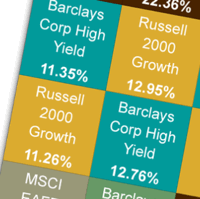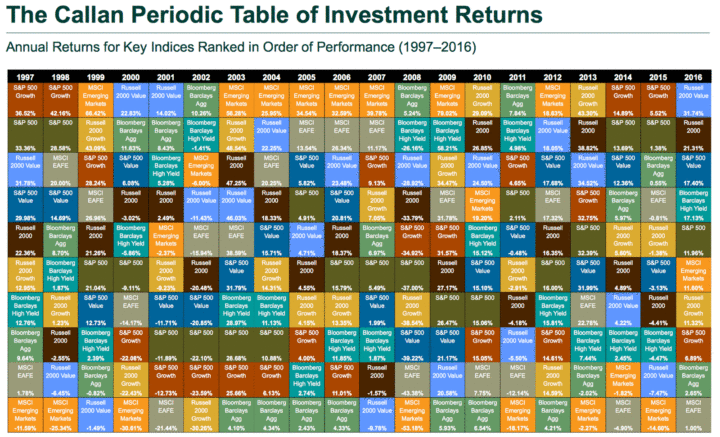 We’ve all been told that past performance is no guarantee of future returns, but it’s still hard to buy an investment that has been performing poorly. We need to remember the historical power of diversification and that even though something may look horrible now, good news may be just around the corner.
We’ve all been told that past performance is no guarantee of future returns, but it’s still hard to buy an investment that has been performing poorly. We need to remember the historical power of diversification and that even though something may look horrible now, good news may be just around the corner.
Callan Associates updates a “periodic table” annually with the relative performance of 8 major asset classes over the last 20 years. You can find the most recent one at their website Callan.com, with access to previous versions requiring free registration.
Every calendar year, the best performing asset class is listed at the top, and it sorts downward until you have the worst performing asset. Here is the most recent snapshot of 1997-2016:
The Callan Periodic Table of Investment Returns conveys the strong case for diversification across asset classes (stocks vs. bonds), investment styles (growth vs. value), capitalizations (large vs. small), and equity markets (U.S. vs. non-U.S.). The Table highlights the uncertainty inherent in all capital markets. Rankings change every year. Also noteworthy is the difference between absolute and relative performance, as returns for the top-performing asset class span a wide range over the past 20 years.
I find it easiest to focus on a specific color (asset class) and then visually noting how its relative performance bounces around. This year, I note that Emerging Markets (Orange) tends to either run really hot or cold. For the past 4 years, Emerging Markets has been near the bottom. MSCI EAFE (Developed Foreign Stocks, Light Grey) have also been doing relatively poorly. I still hold them as they will one day bounce back to the top.

 The Best Credit Card Bonus Offers – March 2024
The Best Credit Card Bonus Offers – March 2024 Big List of Free Stocks from Brokerage Apps
Big List of Free Stocks from Brokerage Apps Best Interest Rates on Cash - March 2024
Best Interest Rates on Cash - March 2024 Free Credit Scores x 3 + Free Credit Monitoring
Free Credit Scores x 3 + Free Credit Monitoring Best No Fee 0% APR Balance Transfer Offers
Best No Fee 0% APR Balance Transfer Offers Little-Known Cellular Data Plans That Can Save Big Money
Little-Known Cellular Data Plans That Can Save Big Money How To Haggle Your Cable or Direct TV Bill
How To Haggle Your Cable or Direct TV Bill Big List of Free Consumer Data Reports (Credit, Rent, Work)
Big List of Free Consumer Data Reports (Credit, Rent, Work)
Great visualization, and provides nice support for the increasingly predominant focus on passive investing with rebalancing.
One thing this makes me ask though, is why you’ve chosen to give extra weight to small cap value and emerging markets stocks in your own portfolio? Is it just that you can’t resist trying to add a little alpha to your otherwise passive approach? (which I would totally understand, if so)
Over the last couple of decades it does appear that both those categories have outperformed somewhat. I only ask the question because the entire point of this (and other) post(s) of yours is that it’s wisest not to try to predict which asset classes will next be king, no?
I admittedly ask this in part because I have a tendency to want to make similar portfolio tweaks, and in part I wouldn’t mind finding justification.
That’s a good question, I think I may have addressed in the past but I can also put a expanded explanation in a new post.
Sure, that would interest me. I think I’ve read most of your posts about portfolio allocation, but I suspect I’m not alone in still wondering a bit why those categories get to have special treatment beyond their market weight!
I know Paul Merriman likes them as part of his “Ultimate Buy and Hold Strategy”, though he also advocates Large Cap Value, and moreover doesn’t include a Total Stock Market equivalent (and I’m sure there are others).
The thing that stands out to me the most is that, as you say, “Emerging Markets (Orange) tends to either run really hot or cold.” However, I was surprised that you didn’t come to the same conclusion I did, given your overall investment style.
My take is that I don’t need that kind of risk in my portfolio. Sure, emerging markets can produce outsize returns, and sure, over the long-haul, they tend to slightly outperform developed markets. However, for an extra 1% or less over the long term, I’d prefer the steadier returns of other investment classes.
My goal in looking at this chart is to find the asset classes that spend all their time in the middle. (OK, maybe a little above the center, but not the best performers.) To that end, I am very lightly weighted in international stocks. Large US companies give you buffered exposure to international returns, which means not so high, but not so low either.
I think that is a fine choice, as long as you stick with it. I like having both because at some point, US stocks are going to have a prolonged slump. It is possible that Emerging or Foreign might slump at the same time, but they might not. Diversification means that not everything will do equally great all the time, but also not everything will do equally awful all the time. But as long as you hold your position and don’t sell after a prolonged bad streak with lots of bad news, or buy only after a prolonged good streak and lots of good news, I think it’ll all work out in the end.